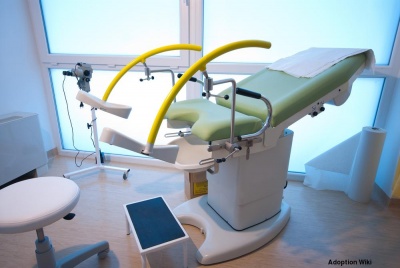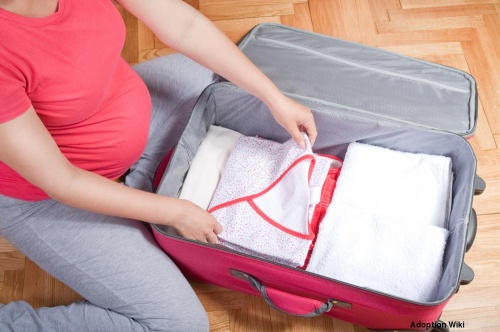Difference between revisions of "Pregnancy Labor and Delivery"
| Line 113: | Line 113: | ||
| − | Back to [[ | + | Back to [[Pregnancy]] |
==Resources== | ==Resources== | ||
Revision as of 18:51, 1 July 2014
When it comes to childbirth, you have options. Find out what choices you have in order to make your experience the most comfortable as possible. Also, get a stage by stage look at what will happen once you start going into labor.
Birthing Options
Where to Have Your Baby
Hospital births provide the greatest medical assistance, with staff looking after you and access to equipment should complications or unforeseen problems arise. Fortunately, many hospitals provide women with birthing rooms where you can go into labor, deliver your baby, and recover all in the same room. Check with your hospital to make sure this type of care is available. You’ll also have the option of how to deliver, whether that’s standing, sitting, squatting, or lying down. Most women still choose hospital births over other options.
Birthing centers are more affordable and have more of a comfortable feel to them. They also focus on natural childbirth, giving you access to birthing pools and a variety of birthing position options. Medical interventions are kept to a minimum. They generally do not use epidurals or labor-inducing drugs like Pitocin. Usually, birthing centers have registered nurses to help with delivery with a physician on call should something go wrong. However about 12 percent of women who start in a birthing center are moved to a hospital due to non-emergency reasons, unforeseen circumstances, like if labor has stalled and Pitocin is needed. Birthing centers should only be considered if the woman is healthy with a low-risk pregnancy and no family history of complications.
Home births is a choice rarely taken anymore. Because of the medical advances and more comfortable accommodations in hospitals, few women choose home births. However, having a home birth can be very comforting, being surrounded by people and things that are loving and familiar to you. If you are considering a home birth, you must have a low-risk pregnancy, have a doctor or certified nurse-midwife to be there for the birth, have transportation and be close to a hospital (within 30 miles with good driving conditions and limited traffic, or within 10 miles if otherwise).
Most people would define "natural childbirth" as a drug free labor. But this is a painful process, and not for everyone.
Purists will tell you that natural childbirth is the only safe way to go--that the risks involved with using medication are too great not only for the baby, but for mom as well. The opposing side will explain that, while there are risks involved with having a medicated childbirth, that there are risks with any childbirth, and that the risk is so small, why would any woman endure the pain that goes along with labor when she doesn't have to?
When women choose to have a natural childbirth, most choose some sort of preparation beforehand. There are three general types of preparation and labor techniques: The Bradley Method, The Grantly Dick-Read Method and, perhaps the most well-known, the Lamaze Method.
The Lamaze method places emphasis on breathing and making productive decisions during laboring, rather than counterproductive decisions (I.E. Screaming).
The Grantly Dick-Read Method is an attempt to remove the cycle of fear and pain from childbirth, relaxing both mother and father.
The Bradley Method teaches relaxation techniques, and uses basic self-hypnosis style birthing.
Many women make the decision to find out what happens as it happens in the delivery room - testing their own thresholds to see if they can bear the pain of labor throughout the entire delivery. Some do, most don't, but the fact remains that the choice is (usually) up to the individual woman. There is no wrong answer, only personal preference.
Getting Ready for the Birth
When to Go to the Hospital:
Many women experience false labor, which feels a lot like labor but doesn’t mean that the child is coming. To know when it’s true labor, watch for contractions coming every five to 15 minutes, lasting over one minute long, and having this process last over an hour. And it shouldn’t die down if you get up or move around. If this happens, get all your last-minute preparations completed and call someone (spouse, coach, family member, etc.) to take you to the hospital. Most women have more than enough time to get to the hospital before they really need to be there. For women with their first child the first stage of labor usually lasts at least eight hours (and up to 12 - 14 hours), seven hours for those who’ve had children before.
What to Do When You Go into Labor
- Call midwife, partner or birth coach, and someone to care for other children, if necessary.
- Get any last-minute things for your overnight bag.
- Get health insurance card, ID, and any needed medical records.
What to Bring:
For Mom:
- Maternity bras
- Underpants
- Nightgown that opens in the front or comfortable pajamas
- Breast pads
- Super-adsorbent sanitary pads
- Warm socks
- Toiletries (makeup, soap, toothbrush, toothpaste, brush)
- Glasses or contact lenses (if needed)
- Insurance information
- Loose-fitting clothes for coming home in
For Baby:
- Newborn diapers
- Infant car seat
- Several pairs of footed pajamas
- A soft hat
- Couple of baby nighties
- One or two receiving blankets
Optional:
- Towel and washcloth
- Slippers
- Bathrobe
- Camera
- CD player, MP3 player, and soothing music
- Cell phone
- Snacks for you and your partner or coach
- Hard candies or lollipops
- Something to massage back during labor (tennis ball, rolling pin, etc.)
- Books for distraction
Stages of Labor
You've spent the last nine months preparing, and now childbirth is imminent. Let's take a step by step look at the childbirth process from first contraction to baby's first cry.
First Stage of Childbirth
The first stage of childbirth is generally the longest, especially for first time moms. You'll go through three phases during this first stage of childbirth.
Early labor
This is the very beginning of the whole show. You may feel a few weak contractions here and there, or possibly just minor cramping or a dull backache that doesn't go away. At this point you probably won't feel too uncomfortable, and actually a little excited to know the big day is finally here.
During this phase, your cervix will dilate (open) to approximately 4 centimeters. You won't need to arrive at the hospital until your contractions are coming a steady 5 minutes apart.
Active labor
Here is where the serious business of childbirth begins. Your contractions will intensify and begin coming closer together, approximately 3 minutes apart. They will start out as a small squeeze and grow to a strong peak, then begin to decrease. At this point you'll likely be feeling a lot more discomfort, and will probably decide whether you want pain medication or if you'll try to tough it out. This phase of childbirth will dilate your cervix to about 8 centimeters. You're almost there.
Transition
This is the most intense part of first stage childbirth. Your contractions will feel extremely strong, come very close together, and last longer. If you took Lamaze classes, now is the time to practice everything you learned as your cervix completely dilates to 10 centimeters. Happily, transition is usually the shortest part of your labor.
Second Stage of Childbirth
During transition, your baby has begun to moved down the birth canal. When transition is complete you are ready to begin the pushing stage of labor that will deliver your baby. Your contractions will change drastically from the sharp intensity of transition to more of a bearing down feeling in the pit of your abdomen.
Your OB will confirm that you are fully dilated, and bring the necessary instruments to assist the birth. When all is ready, your feet will be raised into stirrups that help you to get some leverage for your pushes.
When your next contraction comes, you'll be asked to take a big breath, hold it and begin to push by contracting your abdominal muscles for a count of ten, then expel the breath.
This is the process you'll repeat until the baby's head clears the vaginal opening and then you'll be asked not to push so your OB can suction out the baby's mouth to prevent any inhalation of merconium into the lungs.
Once cleared, your OB will ask you to give a big push with the next contraction. Usually one or two pushes will deliver the baby the rest of the way. The doctor or possibly even your partner will cut the cord and you can meet your new baby.
Third Stage of Childbirth
This stage usually passes fairly unnoticed while you are busy with your new child. A few weaker contractions expel the placenta, and labor is over. Your OB will repair any cuts or tears and you'll be prepped to go to your recovery room.
Congratulations, you've just survived the miracle of childbirth.
Back to Pregnancy
Resources
Stoppard, Miriam. “Conception Pregnancy and Birth.” DK Publishing. 2008. Stone, Joanne; Eddleman, Keith; Duenwald, Mary. “Pregnancy for Dummies.” Wiley Publishing. 2004. Eisenberg, Arlene; Murkoff, Heidi E.; Hathaway, Sandee E. “What to Expect When You’re Expecting” Workman Publishing. 1996.


